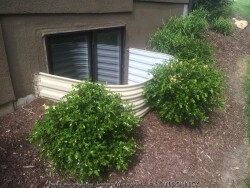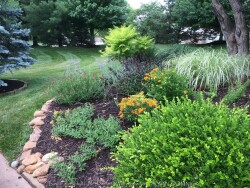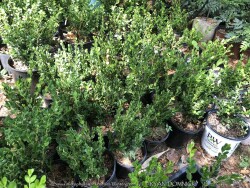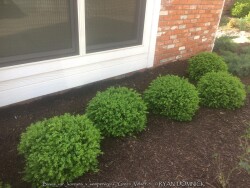

Boxwood (Buxus sp.) is a compact evergreen shrub with small round glossy green leaves. Originating in England and parts of Europe, there are many varieties ranging from small shrubs to small trees. Boxwood varieties grow rather slowly and lend themself excellently to being pruned into hedges as long as not too much is taken off at one time. After a plant achieves a certain height, you may keep it that size indefinitely with 3 to 4 times per year pruning. Boxwoods prefer part shade with rich to average well-drained soil and average moisture. Boxwoods planted in the full sun will survive but develop an burnt yellowish green color when temperatures exceed 100°F. This is usually a problem in zone 6 or further south as there are many better choices for full sun. (morning sun is okay) In zones 4-5, afternoon full sun is probably okay. Boxwoods are best known for their tolerance to dry shade even under root bound conditions. They will not survive more than a couple years under a roof overhang due to lack of moisture in the winter and spider mite problems. In the Eastern and Southeastern United States, Boxwoods have many problems including root rot, insect and disease issues. None of these are a problem in Kansas or Oklahoma with lower rainfall amounts and less humidity. In the landscape, yews offer a year-round structure. They definitely help provide a background for more interesting plants with colorful foliage and flowers. They are also very well known and used in formal garden designs. We prefer to see them less pruned and in their more natural state. Emerald Jewel Boxwood (Buxus microphylla var. koreana 'Emerald Jewel') has improved shinier light green spring foliage darkening by summer. Foliage maintains a "better" green in winter compared to other varieties. There is also no die back or twig blight problems like with Green Velvet Boxwood.


Boxwood (Buxus sp.) is a compact evergreen shrub with small round glossy green leaves. Originating in England and parts of Europe, there are many varieties ranging from small shrubs to small trees. Boxwood varieties grow rather slowly and lend themself excellently to being pruned into hedges as long as not too much is taken off at one time. After a plant achieves a certain height, you may keep it that size indefinitely with 3 to 4 times per year pruning. Boxwoods prefer part shade with rich to average well-drained soil and average moisture. Boxwoods planted in the full sun will survive but develop an burnt yellowish green color when temperatures exceed 100°F. This is usually a problem in zone 6 or further south as there are many better choices for full sun. (morning sun is okay) In zones 4-5, afternoon full sun is probably okay. Boxwoods are best known for their tolerance to dry shade even under root bound conditions. They will not survive more than a couple years under a roof overhang due to lack of moisture in the winter and spider mite problems. In the Eastern and Southeastern United States, Boxwoods have many problems including root rot, insect and disease issues. None of these are a problem in Kansas or Oklahoma with lower rainfall amounts and less humidity. In the landscape, yews offer a year-round structure. They definitely help provide a background for more interesting plants with colorful foliage and flowers. They are also very well known and used in formal garden designs. We prefer to see them less pruned and in their more natural state. Wintergreen Boxwood (Buxus microphylla var. koreana 'Wintergreen') has improved shinier light green spring foliage darkening by summer. Foliage maintains a "better" green in winter compared to other varieties. There is also no die back or twig blight problems like with Green Velvet Boxwood.


Boxwood (Buxus sp.) is a compact evergreen shrub with small round glossy green leaves. Originating in England and parts of Europe, there are many varieties ranging from small shrubs to small trees. Boxwood varieties grow rather slowly and lend themself excellently to being pruned into hedges as long as not too much is taken off at one time. After a plant achieves a certain height, you may keep it that size indefinitely with 3 to 4 times per year pruning. Boxwoods prefer part shade with rich to average well-drained soil and average moisture. Boxwoods planted in the full sun will survive but develop an burnt yellowish green color when temperatures exceed 100°F. This is usually a problem in zone 6 or further south as there are many better choices for full sun. (morning sun is okay) In zones 4-5, afternoon full sun is probably okay. Boxwoods are best known for their tolerance to dry shade even under root bound conditions. They will not survive more than a couple years under a roof overhang due to lack of moisture in the winter and spider mite problems. In the Eastern and Southeastern United States, Boxwoods have many problems including root rot, insect and disease issues. None of these are a problem in Kansas or Oklahoma with lower rainfall amounts and less humidity. In the landscape, yews offer a year-round structure. They definitely help provide a background for more interesting plants with colorful foliage and flowers. They are also very well known and used in formal garden designs. We prefer to see them less pruned and in their more natural state. Wintergreen Boxwood (Buxus microphylla var. koreana 'Wintergreen') has improved shinier light green spring foliage darkening by summer. Foliage maintains a "better" green in winter compared to other varieties. There is also no die back or twig blight problems like with Green Velvet Boxwood.


Boxwood (Buxus sp.) is a compact evergreen shrub with small round glossy green leaves. Originating in England and parts of Europe, there are many varieties ranging from small shrubs to small trees. Boxwood varieties grow rather slowly and lend themself excellently to being pruned into hedges as long as not too much is taken off at one time. After a plant achieves a certain height, you may keep it that size indefinitely with 3 to 4 times per year pruning. Boxwoods prefer part shade with rich to average well-drained soil and average moisture. Boxwoods planted in the full sun will survive but develop an burnt yellowish green color when temperatures exceed 100°F. This is usually a problem in zone 6 or further south as there are many better choices for full sun. (morning sun is okay) In zones 4-5, afternoon full sun is probably okay. Boxwoods are best known for their tolerance to dry shade even under root bound conditions. They will not survive more than a couple years under a roof overhang due to lack of moisture in the winter and spider mite problems. In the Eastern and Southeastern United States, Boxwoods have many problems including root rot, insect and disease issues. None of these are a problem in Kansas or Oklahoma with lower rainfall amounts and less humidity. In the landscape, yews offer a year-round structure. They definitely help provide a background for more interesting plants with colorful foliage and flowers. They are also very well known and used in formal garden designs. We prefer to see them less pruned and in their more natural state.